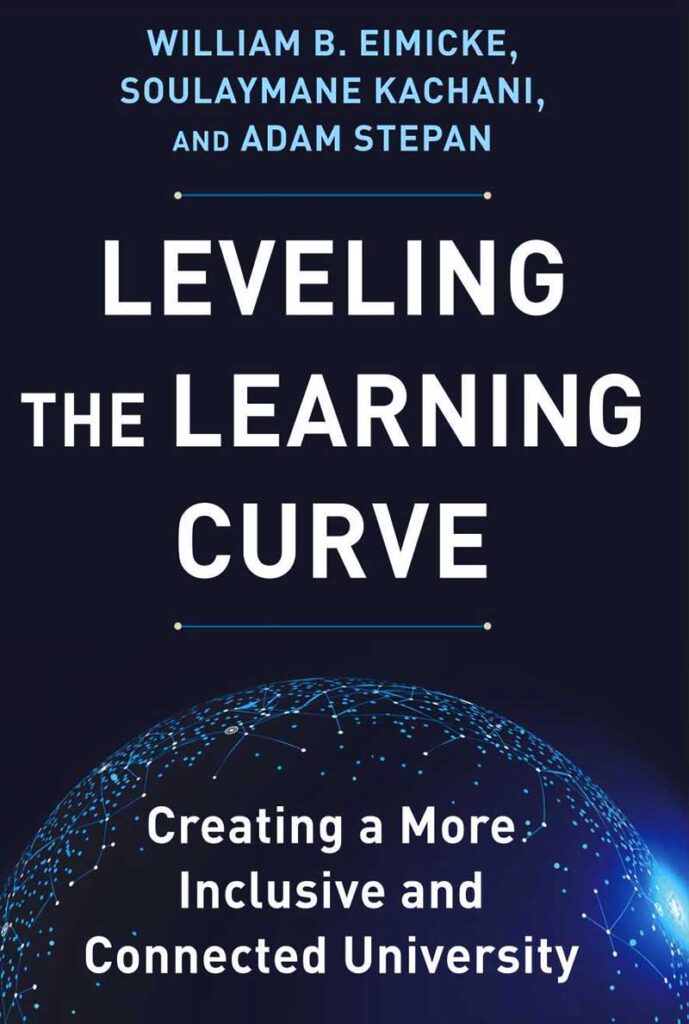Digital education has acquired something of a bad reputation in recent years. During the pandemic, countless schools and universities across the globe moved classes online for the first time, but their hasty, forced adoption of digital learning often led to less than ideal outcomes. Around the world, the pandemic cost schoolchildren about one-third of a year’s worth of learning, according to one estimate [2]. Its impact on less well-off students was especially severe. A recent UNESCO report [3] concluded that dependence on digital learning technologies during the pandemic led to “staggering” levels of educational inequality. This outcome, according to the report, was an “ed-tech tragedy.”
But does the embrace of digital education always end in disaster?
A new book, Leveling the Learning Curve [4] by William B. Eimicke, Soulaymane Kachani, and Adam Stepan, argues that it doesn’t. In fact, its authors suggest, well-designed digital education can actually improve educational outcomes and reduce learning disparities.
WENR sat down with Stepan [5], director of Columbia University’s Picker Center Digital Educational Group and one of the book’s authors, to explore the connection between digital connectivity and educational inclusivity. Despite gloomy assessments, countless examples of real-world success have convinced Stepan that digital education has the potential to be more than a temporary fix. Designed and delivered with intention, digital education can form “an integral part of a more inclusive and effective learning ecosystem,” Stepan believes.
This interview has been edited for brevity and clarity.
Can you tell us what inspired you and your two co-authors to write the new book Leveling the Learning Curve, and to write it?
Over the past decade, our journey in the digital education space has been both enlightening and transformative. Back in 2012 and 2013, when massive open online courses (MOOCs) like edX and Coursera emerged, there was a sense of anticipation that they would revolutionize higher education. Many of us saw it as a radical and disruptive change, akin to the transformation witnessed in other industries such as publishing and journalism through the use of digital tools. This belief prompted us to delve into this new territory and explore its potential.
However, as time went on, it became evident that the impact of MOOCs was not as transformative as initially anticipated. While they garnered attention, they did not reach as many students as expected, and the revolutionary changes within higher education remained somewhat elusive. Nevertheless, their presence did spark a significant shift in the way universities approached teaching and learning.
Following the emergence of MOOCs, many universities established Centers for Teaching and Learning to address the challenges and possibilities brought forth by digital education. This was a paradigm shift, as universities had not focused on these issues in such a comprehensive manner for quite some time. It was a recognition that the traditional model of education needed to evolve and adapt to the realities of the digital age.
If you were to walk into most university classrooms before the pandemic, you would find a teaching model that had remained largely unchanged for over a century. The format of a lecturer addressing students in person, with the students seated, mirrored the practices of the 19th century. Despite the transformative power of digital technology in various aspects of life, higher education seemed to be lagging.
Then, the pandemic hit, and the world was forced to adapt quickly. Overnight, education had to transition online, but the hastily implemented online learning solutions were far from ideal. We knew that there were better, well-designed, and well-delivered digital education models out there. However, such models require careful planning, thoughtful execution, and effective management.
The pandemic served as an emergency catalyst for the continuation of learning, but it also highlighted the need to explore what else was possible in the realm of digital education. We wanted to tell the story of the untapped potential and the ongoing developments in this space. The experiences of the pandemic compelled us to envision a future where digital education is not just a stopgap measure but an integral part of a more inclusive and effective learning ecosystem.
So, we wanted to shed light on the advancements, opportunities, and possibilities that exist beyond the emergency response to the pandemic. By exploring the untapped potential of digital education, we hope to inspire educators, institutions, and policymakers to envision a future where well-designed and well-delivered digital education becomes the norm, providing inclusive and impactful learning experiences for all.
How can digital education help bridge education gaps and ensure equal opportunities for learners?
Universities, as reflected in their mission statements, have knowledge sharing as a central purpose. However, the evaluation and critical discussion of how knowledge is shared have been lacking for some time. We believe universities should put more effort into fulfilling their obligation to share knowledge widely, extending beyond those who can afford to be physically present on their campuses. They should actively create and disseminate knowledge that can address society’s most pressing issues.
Thankfully, more universities are awakening to this idea and recognizing their responsibility to share knowledge beyond their immediate classrooms. They are beginning to explore ways to achieve this goal. While financial sustainability is essential, we argue that there is ample room for universities to create exceptional learning experiences both on campus and online, while also generating resources that can be shared. This sharing of knowledge can lead to significant positive developments, crucial for the survival of our planet. It allows individuals who currently lack access to high-quality education to be trained, contribute their ideas, and participate in important discussions in their respective countries.
Our greater mission is to demonstrate how digital tools can facilitate this new era of sharing and engagement. By embracing these tools, universities have the potential to make a meaningful impact on a global scale.
Can you share any success stories that demonstrate how digital education initiatives can level the learning curve?
We are thrilled about our digital case study program, which was specifically developed to enhance teaching at Columbia University’s School of International and Public Affairs [7] (SIPA). This program caters to students from 150 countries who aspire to senior roles in various governments, the World Bank, or the UN. Given the complexity of the issues they encounter, we have created video and written case studies that delve into specific topics such as data-driven city management or innovative health care delivery methods. We explore these subjects through real-world examples, showcasing solutions from diverse locations like Mumbai, San Paulo, and Lithuania.
Originally intended for our own programs and executive education classes at SIPA, we decided to share these case studies openly with universities worldwide. We wanted to foster collaboration and learn about the different ways they incorporate these resources into their curricula. Currently, over 250 institutions and groups globally utilize our collection, and it’s fascinating to witness how they adapt and apply the materials to their unique contexts. These case studies have found relevance in numerous countries and programs, often in ways we could not have anticipated. Local professors recognize their value in sparking discussions and exploring relevant issues in their classrooms, even beyond the original locations where the case studies were filmed.
Our book showcases numerous examples like this, highlighting the generosity and innovative efforts of our colleagues. For instance, Cornell University has created exceptional classes, including legal courses featuring lectures from prominent lawyers. They have packaged these classes for short courses and also provided some for free, including collaborations with the government of Rwanda to train individuals in the hospitality sector.
Additionally, Stanford University has recently established a center dedicated to utilizing digital tools as part of their public mission. They are engaged in remarkable initiatives, such as creating online programs for high schools, benefiting both Stanford students and high school learners. These endeavors represent exciting trends that demonstrate the diverse and impactful ways educational resources can be employed.
Another successful initiative, the Open Society University Network (OSUN) was launched in January 2020, just before the pandemic. OSUN builds upon the groundwork laid by Bard College, a renowned liberal arts institution in New York, led by Jonathan Becker. Their efforts focused on introducing liberal arts learning to countries with emerging democracies or limited exposure to such education. The goal of OSUN is to expand this model and explore the feasibility of teaching liberal arts at scale. We were delighted to be part of the initial team, as it provided an opportunity to work with a slightly different learning management system and evaluate our practices at Columbia, given our extensive international engagements through global centers.
An exciting aspect of OSUN is the network of collaborative classes, which combines local teaching with a shared curriculum and online meetings. This allows learners from diverse backgrounds, such as those in Lithuania, Kurdistan, or a refugee camp in Kenya, to benefit from interacting with peers in different parts of the world. Technology plays a vital role in facilitating this global learning experience.
OSUN’s vision aligns with the idea of creating training guides that empower individuals to generate locally relevant content of high quality. This parallels the model employed by TED when they introduced TEDx, enabling people worldwide to deliver TED-style talks. By offering training guides, we explore the potential for similar localized initiatives within different domains.
We feel privileged to be a partner of OSUN and encourage everyone to explore their website [8] and discover the exciting opportunities and valuable learning experiences they provide.
You mentioned the success of SIPA’s digital case studies. Could you elaborate more on how the program came to be and what makes it successful?
I found tremendous inspiration when I first encountered TED Talks. Witnessing the power of such documentary-style presentations profoundly impacted me, especially since I grew up in a time when there were only a few outlets for documentaries, such as the BBC and National Geographic. The advent of YouTube and other digital platforms revolutionized the landscape, prompting us to question how we could harness these new tools effectively. This parallels the current situation with artificial intelligence (AI), where we face similar questions about utilizing emerging technologies.
In our exploration, we examined successful platforms like Khan Academy and TED Talks and sought to understand the factors behind their effectiveness. One common element we observed was the presence of a trusted platform. Additionally, we realized that replicating a traditional teaching model, as some early MOOCs attempted to do, was not optimal. It was akin to filming a play and calling it a movie, missing the opportunity to leverage the unique qualities of the medium. Instead, we proposed a model of digital education that involved shorter, modular learning experiences, similar to TED Talks. These bite-sized modules could be used flexibly by different teachers and learners.
Rather than offering lengthy, semester-long courses, we envisioned a platform where users could access concise, peer-reviewed videos on specific topics of interest. By creating a collection of fantastic talks reviewed for quality, we aimed to provide a resource akin to peer-reviewed articles, free from any biased agenda. This concept led us to develop what we call digital case studies—a platform for sharing modular, shorter pieces of knowledge. We believe universities must consider creating digital assets that are adaptable and shareable across various contexts. These assets, such as case studies or filmed lectures, could be used in traditional on-campus classrooms, executive education programs, or even distributed freely to non-governmental organizations as part of a university’s mission to disseminate knowledge.
The core driving force behind our work lies in the idea of sharing knowledge through easily shareable and modular assets.
What are some additional strategies or initiatives that educational institutions can adopt to promote equitable learning opportunities?
As an institution, it is crucial to examine your own practices and consider what can be done for your students and beyond. The current setup of universities, including management systems, structures, and tenure processes, has been in place for a considerable time. However, it is worth questioning whether adjustments can be made to prioritize the needs of students. For instance, evaluating to what extent teaching is considered in the process of assessing professors could be a valuable inquiry.
There are relatively inexpensive and straightforward ways to enhance the digital aspect of teaching at many universities. One such approach is hiring teaching assistants who can support professors in creating better class websites and developing more engaging online activities. By involving teaching assistants earlier in the cycle and giving them a clearer mission to improve the digital experience, significant progress can be made in enriching students’ learning journeys.
Additionally, our focus has been on planned digital education, where we found that some of the most significant innovations have emerged from large public universities. These institutions, with their mission to reach a wide audience, have actively explored how to film classes at scale and create effective online courses. Contrary to the assumption that online courses require less support, they have discovered that students often require additional assistance. This realization has led us to advocate for a higher ratio of faculty or teaching assistants to students in well-run online courses, ensuring the necessary support is available.
These improvements primarily involve management adjustments rather than technological changes. It is essential to recognize that integrating digital technology often requires additional work for professors. By acknowledging this and providing incentives such as extra compensation or time off, professors can feel motivated to invest in technology, resulting in a win-win situation for the institution, professors, and students.
What role should policymakers and governments play in promoting digital connectivity and leveling the learning curve?
In our book, we explored national programs in India and Israel that utilized MOOCs and digital education to enhance education on a broader scale.
A noteworthy finding was that government-run organizations in both countries were able to leverage their influence over the educational system to overcome obstacles. One recurring barrier was the issue of credits. Even within state-run university systems, students often face difficulties transferring credits or utilizing credits obtained from free online courses toward their degrees. However, the governments in India and Israel recognized the value of allowing students to earn credits through inexpensive online courses. They intervened by providing additional funding for the creation of online classes while requiring universities to accept credits from similar programs. This government-led initiative proved beneficial for all parties involved: Students could graduate sooner, the government spent less money, and universities received additional funding for online programs.
While we do not advocate that universities be entirely government-run, we believe certain levers can be utilized to overcome roadblocks. The independent non-profit sector has proved to be an excellent source of innovation, and we do not suggest excessive government regulation. However, strategic interventions, like the example mentioned, can enable universities to navigate challenges and embrace digital education more effectively.
Looking ahead, what do you envision as the future of digital education and its potential to further reduce educational inequalities?
Generative AI has become a significant topic of interest, especially with the launch of ChatGPT. As we completed our book, we had to reconsider its implications. Universities are poised to enter a golden age of relevance and collaboration. In this era, lifelong learning is crucial, as individuals will need to continuously update their skills. The concept of a 60-year curriculum is becoming a reality.
Digital education tools, including AI, will play a vital role in this transformation. Universities need to embrace AI seriously to avoid its domination by commercial interests focused solely on easily marketable applications. Courageous engagement with AI can lead to the creation of adaptive learning experiences tailored to individual needs. For example, the learning requirements of a 12-year-old exploring climate change differ from those of a 15-year-old or a 21-year-old. Universities must find ways to combine engagement and scale, leveraging the power of peer interaction and group learning.
Our experiments emphasize the importance of engagement and scale. These two factors are crucial not only in education but also in various aspects of our current economy, as demonstrated by platforms like Twitter [now X], Facebook, Instagram, and TikTok. We must consider how to utilize these new tools to meaningfully address the concerns and issues facing young people and our planet. Empowering individuals to solve problems and contribute to a better world requires focused efforts from university leaders.
The upcoming years promise excitement, and we feel fortunate to be at the forefront of these developments. Collaborating with extraordinary colleagues who generously share their work and vision reassures us that we are not alone in our endeavors. Together, we work towards common goals, making this journey even more thrilling.
Leveling the Learning Curve: Creating a More Inclusive and Connected University [4], by William B. Eimicke, Soulaymane Kachani, and Adam Stepan, is available from Columbia University Press.



